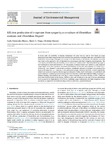Mostrar o rexistro simple do ítem
Efficient Production of 𝑛-Caproate From Syngas by a Co-culture of Clostridium Aceticum and Clostridium Kluyveri
| dc.contributor.author | Fernández-Blanco, Carla | |
| dc.contributor.author | Veiga, María Carmen | |
| dc.contributor.author | Kennes, Christian | |
| dc.date.accessioned | 2022-02-22T14:03:00Z | |
| dc.date.available | 2022-02-22T14:03:00Z | |
| dc.date.issued | 2021-10-25 | |
| dc.identifier.citation | Fernández-Blanco, C., Veiga, M.C., Kennes, C., 2022. Efficient production of 𝑛--caproate from syngas by a co-culture of Clostridium aceticum and Clostridium kluyveri, Journal of Environmental Management 302, 113992. doi: 10.1016/j.jenvman.2021.113992. | es_ES |
| dc.identifier.issn | 0301-4797 | |
| dc.identifier.uri | http://hdl.handle.net/2183/29829 | |
| dc.description | Financiado para publicación en acceso aberto: Universidade da Coruña/CISUG | |
| dc.description.abstract | [Abstract] In recent years, the possibility of merging technologies for waste recovery such as those based on syngas fermentation and chain elongation has been studied for the production of medium chain fatty acids (MCFAs) and bioalcohols, in an attempt to integrate the concept of circular economy in the industry. Nevertheless, one of the main issues of this approach is the pH mismatch between acetogens and chain elongating microorganisms. This work reports, for the first time, the suitability of a co-culture of C. aceticum and C. kluyveri metabolizing syngas at near neutral pH in stirred tank bioreactors. For this purpose, bioreactor studies were carried out with continuous syngas supply. In the first experiment, maximum concentrations of 𝑛-butyrate and 𝑛-caproate of 7.0 and 8.2 g/L, respectively, were obtained. In the second experiment, considerable amounts of 𝑛-butanol were produced as a result of the reduction, by C. aceticum, of the carboxylates already formed in the broth. In both experiments, ethanol was used as an exogenous electron agent at some point. Finally, batch bottle assays were performed with a pure culture of C. aceticum grown on CO in presence of n-butyrate to assess and confirm its ability to produce 𝑛-butanol, reaching concentrations up to 951 mg/L, with a 𝑛-butyrate conversion efficiency of 96%, which had never been reported before in this species. Therefore, this work contributes to the state of the art, presenting a novel system for the bioproduction of MCFAs by combining syngas fermentation and chain elongation at near neutral pH, as opposed to the acidic pH range used in all previously reported literature. | es_ES |
| dc.description.sponsorship | This research was funded through the Spanish Ministry of Science and Innovation and European FEDER funds (PID2020-117805RB-I00). CFB thanks Xunta de Galicia for her doctoral contract (ED481A-2020/028). The authors, belonging to the BIOENGIN group, thank Xunta de Galicia for financial support to Competitive Reference Research Groups (ED431C 2021/55). Funding for open access charge provided by Universidade da Coruña/CISUG | es_ES |
| dc.description.sponsorship | Xunta de Galicia; ED481A-2020/028 | es_ES |
| dc.description.sponsorship | Xunta de Galicia; ED431C 2021/55 | es_ES |
| dc.language.iso | eng | es_ES |
| dc.publisher | Elsevier | es_ES |
| dc.relation | info:eu-repo/grantAgreement/AEI/Plan Estatal de Investigación Científica y Técnica y de Innovación 2017-2020/PID2020-117805RB-I00/ES/ | |
| dc.relation.uri | https://doi.org/10.1016/j.jenvman.2021.113992 | es_ES |
| dc.rights | Atribución-NoComercial-SinDerivadas 4.0 Internacional | es_ES |
| dc.rights.uri | http://creativecommons.org/licenses/by-nc-nd/4.0/ | * |
| dc.subject | Syngas fermentation | es_ES |
| dc.subject | Chain elongation | es_ES |
| dc.subject | Clostridium aceticum | es_ES |
| dc.subject | Clostridium kluyveri | es_ES |
| dc.subject | 𝑛-Caproate | es_ES |
| dc.subject | 𝑛-Butanol | es_ES |
| dc.title | Efficient Production of 𝑛-Caproate From Syngas by a Co-culture of Clostridium Aceticum and Clostridium Kluyveri | es_ES |
| dc.type | info:eu-repo/semantics/article | es_ES |
| dc.rights.access | info:eu-repo/semantics/openAccess | es_ES |
| UDC.journalTitle | Journal of Environmental Management | es_ES |
| UDC.volume | 302, Part A | es_ES |
| UDC.startPage | 113992 | es_ES |
Ficheiros no ítem
Este ítem aparece na(s) seguinte(s) colección(s)
-
GI-BIOENGIN- Artigos [91]






